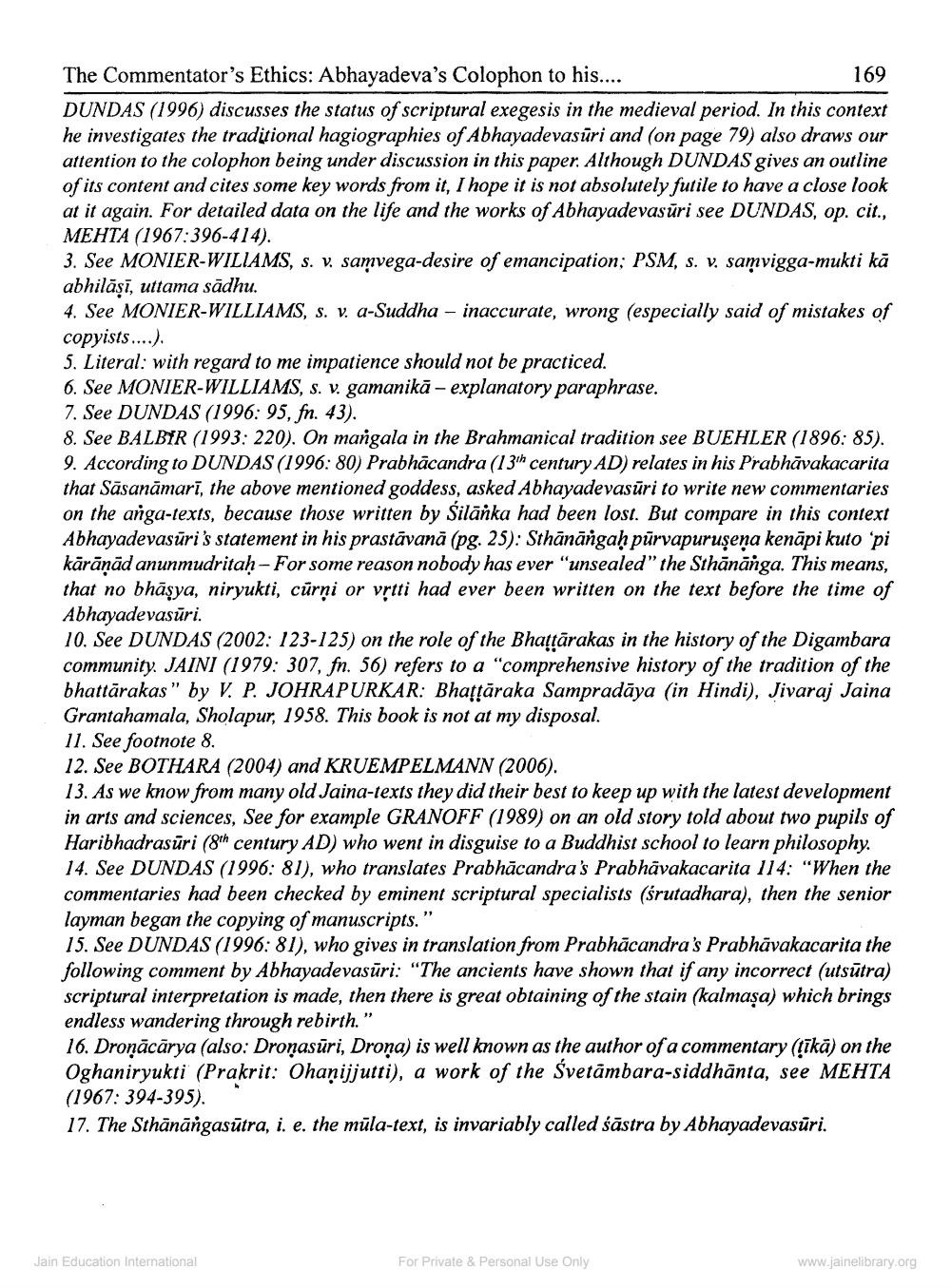________________
The Commentator's Ethics: Abhayadeva's Colophon to his....
169 DUNDAS (1996) discusses the status of scriptural exegesis in the medieval period. In this context he investigates the traditional hagiographies of Abhayadevasūri and (on page 79) also draws our attention to the colophon being under discussion in this paper. Although DUNDAS gives an outline of its content and cites some key words from it, I hope it is not absolutely futile to have a close look at it again. For detailed data on the life and the works of Abhayadevasūri see DUNDAS, op. cit., MEHTA (1967:396-414). 3. See MONIER-WILIAMS, s. v samvega-desire of emancipation; PSM, s. v. samvigga-mukti kā abhilāṣī, uttama sādhu. 4. See MONIER-WILLIAMS, s. v. a-Suddha - inaccurate, wrong (especially said of mistakes of copyists ....) 5. Literal: with regard to me impatience should not be practiced. 6. See MONIER-WILLIAMS, s. v. gamanikā - explanatory paraphrase. 7. See DUNDAS (1996: 95, fn. 43). 8. See BALBYR (1993: 220). On mangala in the Brahmanical tradition see BUEHLER (1896: 85). 9. According to DUNDAS (1996: 80) Prabhācandra (1 3ih century AD) relates in his Prabhāvakacarita that Sāsanāmarī, the above mentioned goddess, asked Abhayadevasūri to write new commentaries on the anga-texts, because those written by Silānka had been lost. But compare in this context Abhayadevasūri's statement in his prastāvanā (pg. 25): Sthānāngah pūrvapurusena kenāpi kuto 'pi kārāņād anunmudritah- For some reason nobody has ever "unsealed" the Sthānanga. This means, that no bhāşya, niryukti, cürņi or vrtti had ever been written on the text before the time of Abhayadevasūri. 10. See DUNDAS (2002: 123-125) on the role of the Bhattārakas in the history of the Digambara community. JAINI (1979: 307, fn. 56) refers to a "comprehensive history of the tradition of the bhattārakas" by V. P. JOHRAPURKAR: Bhattāraka Sampradāya (in Hindi), Jivaraj Jaina Grantahamala, Sholapur, 1958. This book is not at my disposal. 11. See footnote 8. 12. See BOTHARA (2004) and KRUEMPELMANN (2006). 13. As we know from many old Jaina-texts they did their best to keep up with the latest development in arts and sciences, See for example GRANOFF (1989) on an old story told about two pupils of Haribhadrasūri (8th century AD) who went in disguise to a Buddhist school to learn philosophy. 14. See DUNDAS (1996: 81), who translates Prabhācandra's Prabhāvakacarita 114: "When the commentaries had been checked by eminent scriptural specialists (śrutadhara), then the senior layman began the copying of manuscripts." 15. See DUNDAS (1996: 81), who gives in translation from Prabhācandra's Prabhāvakacarita the following comment by Abhayadevasūri: "The ancients have shown that if any incorrect (utsūtra) scriptural interpretation is made, then there is great obtaining of the stain (kalmaşa) which brings endless wandering through rebirth." 16. Droņācārya (also: Dronasūri, Drona) is well known as the author of a commentary (țīkā) on the Oghaniryukti (Prakrit: Ohanijjutti), a work of the Svetambara-siddhānta, see MEHTA (1967: 394-395). 17. The Sthānāngasūtra, i. e. the mūla-text, is invariably called śāstra by Abhayadevasūri.
Jain Education International
For Private & Personal Use Only
www.jainelibrary.org




